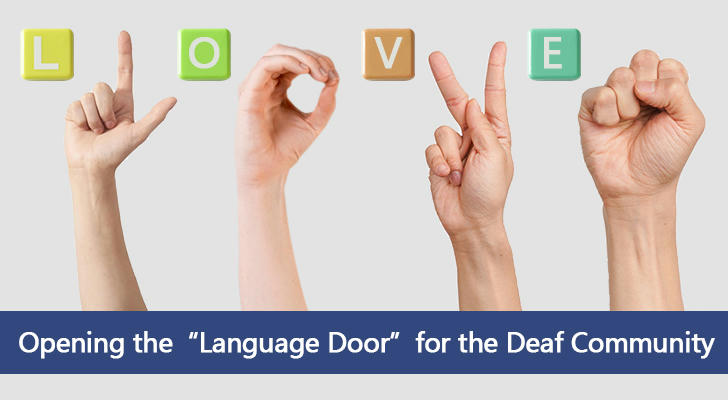Opening the “Language Door” for the Deaf Community
🤟 Sign Language Interpreting: Opening the “Language Door” for the Deaf Community
In this fast-paced information age, communication skills are a crucial bridge for people to connect and participate in social activities. However, for the deaf community, traditional spoken languages often become barriers to accessing the world.
Sign language interpreting serves as that bridge — connecting the “silent world” with the “hearing society.”

🌟 Sign Language Interpreting: A Skill and a Responsibility
Learning sign language interpreting is not only about mastering a language skill but also about promoting social fairness and inclusion. Helping deaf individuals receive and convey information in real time is an essential communication link between the silent world and mainstream society.
💡 With only a few hundred dollars invested in learning, you can earn tens of thousands of dollars annually, work freelance, work from home, and even change someone’s life.
In the United States, there are over 11 million people who are deaf or hard of hearing.
Courts, hospitals, schools, and businesses are all actively looking for qualified sign language interpreters — but there is a severe shortage of certified professionals.
Once you’ve mastered this skill, you’ll be able to:
✅ Work remotely charging $30–$50 per hour
✅ Take orders from home, balancing main job and life easily
✅ No degree required, no major restrictions, learn from zero basics
✅ After certification, enter high-paying fields like healthcare, education, and government
✅ Master practical skills in 3 months and recoup your investment within a year
💡 Why Learn Sign Language Interpreting? Five Major Benefits for People with Disabilities
✅ 1. Break Communication Barriers and Enhance Independent Living
🧏♀️ For deaf individuals, whether at hospitals, job interviews, legal consultations, or classrooms, sign language interpreting enables barrier-free communication, helping them independently complete various social activities and reducing their reliance on others.
📌 Example: Many hospitals now have video sign language interpreting systems, allowing deaf patients to see doctors, ask questions, and get prescriptions independently.
💡 Real Case: A Deaf Mother’s Successful Delivery Thanks to Sign Language Interpreting
At a U.S. hospital, a deaf mother was anxious during labor as she couldn’t hear the doctor’s instructions. The hospital urgently arranged a remote sign language interpreter (via video screen). With the interpreter’s help, the doctor and mother cooperated successfully to complete the delivery. The mother said, “This was not just an interpreter; this was my ‘life support.’”
💡 Insight: In medical scenarios, sign language interpreting is not just a service but a safety guarantee.
✅ 2. Stable and Growing Job Prospects
With government emphasis on accessibility, demand for professional sign language interpreters in TV stations, courts, hospitals, schools, and public services is continuously growing.
Policy support + Aging population + Increasing disability rights awareness = Expanding market
✅ 3. Flexible Work Modes (Full-time, Freelance, Remote)
Sign language interpreters can be:
Full-time employees in education, judiciary, media, etc.
Freelancers accepting projects with good income
Remote/online interpreters through video platforms, offering flexibility and home-friendly work
Highly flexible, allowing learning while working, suitable for side jobs or stay-at-home parents.
Many interpreters follow the path: “initial exposure → learning → working and improving.” With 6 months to 1 year of training, skills can be converted into income.
✅ 4. Competitive Salary and High Career Return
| Type | Income Range | Description |
|---|---|---|
| Beginner/Entry-level | $20–$30/hour | Gain experience through community or online jobs |
| Certified Professional (e.g., RID-certified) | $45–$60+/hour | Higher rates for courts, medical, government projects |
| Full-time Positions (Schools, Government) | $40000–$75000/year | Includes health insurance, retirement benefits |
| Freelance (Project-based) | $200–$600/day | Flexible jobs, income uncapped |
With certification and sufficient experience, earning six figures ($100,000+) annually in the U.S. is not uncommon.
✅ 5. Clear Learning Path and Measurable Growth
From basic sign language → oral interpretation → industry-specific translation → certification → advanced roles, the path is clear and the timeline controllable.
What Does a Sign Language Interpreting Course Cover?
A systematic sign language interpreting course typically includes:
Basic Sign Language: everyday expressions, numbers, time, colors, professions
Language Structure and Grammar: learning sign language syntax and how to translate from spoken language
Deaf Culture and Ethics: understanding deaf culture, identity, social customs, and interpreter codes of conduct
Practical Training: TV news interpreting, courtroom simulations, conference interpreting
Certification Preparation: helping learners prepare for professional interpreting exams
Courses usually have beginner, intermediate, and advanced levels, supported by rich video resources, role-playing scenarios, and in-person practice opportunities, helping learners grow from zero to professional interpreters.

🧩 Removing Communication Barriers, Making Careers More Meaningful
Whether you are new or have some foundation, joining a sign language interpreting course starts your professional growth journey — a quiet yet profound transformation in your life.
